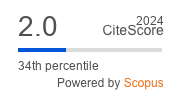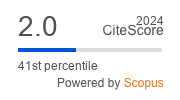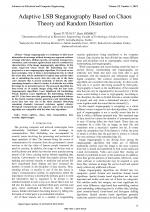| 3/2018 - 3 |
Adaptive LSB Steganography Based on Chaos Theory and Random DistortionTUTUNCU, K. |
| Extra paper information in |
| Click to see author's profile in |
| Download PDF |
Author keywords
ciphers, chaos, data encapsulation, data security, digital images
References keywords
image(17), steganography(15), chaotic(11), hiding(10), steganographic(9), information(8), algorithm(8), communications(7), signal(5), security(5)
Blue keywords are present in both the references section and the paper title.
About this article
Date of Publication: 2018-08-31
Volume 18, Issue 3, Year 2018, On page(s): 15 - 22
ISSN: 1582-7445, e-ISSN: 1844-7600
Digital Object Identifier: 10.4316/AECE.2018.03003
Web of Science Accession Number: 000442420900003
SCOPUS ID: 85052105181
Abstract
Image steganography is a technique to hide secret information in an image without leaving any apparent evidence of image alteration. Hiding capacity, perceptual transparency, robustness, and resistance against attack must be considered as characteristics of the image steganography algorithms. In this study, Improved Chaos Based Bit Embedding has been proposed as a new steganography algorithm. It is based on two basic principles. One of them is determining the bits in which the secret data will be embedded by logistic map and the other one is embedding the secret data into only one of the three color channels that is chosen randomly. It distorts the other remaining channels so that it is harder to obtain the text within the image by an unwanted person. The proposed algorithm has been tested on 10 sample images along with the four basic steganography algorithms: Least Significant Bit Embedding, Pseudo Random Least Significant Bit Embedding, EzStego, and F5. It has been seen that generating unpredictable indexes by the chaotic random number generators, and embedding the secret data into only one of the three channels (distorting remaining channels) increased resistance against attacks. Perceptual transparencies and capacity ratio of the proposed algorithm are compatible with the other four algorithms. |
| References | | | Cited By «-- Click to see who has cited this paper |
| [1] A. Beimel, "Secret-Sharing Schemes: A Survey," in Coding and Cryptology, 2011, pp. 11-46. [CrossRef] [SCOPUS Times Cited 528] [2] A. Shamir, "How to Share a Secret," Commun. ACM, vol. 22, no. 11, pp. 612-613, Nov. 1979. [CrossRef] [SCOPUS Times Cited 11304] [3] A. Cheddad, J. Condell, K. Curran, and P. Mc Kevitt, "Digital image steganography: Survey and analysis of current methods," Signal Processing, vol. 90, no. 3, pp. 727-752, Mar. 2010. [CrossRef] [SCOPUS Times Cited 1379] [4] C. Kurak and J. McHugh, "A cautionary note on image downgrading," in [1992] Proceedings Eighth Annual Computer Security Application Conference, 1992, pp. 153-159. [CrossRef] [SCOPUS Times Cited 103] [5] I. S. Moskowitz, G. E. Longdon, and L. Chang, "A new paradigm hidden in steganography," in Proceedings of the 2000 workshop on New security paradigms, 2001, pp. 41-50. [CrossRef] [6] T. Sharp, "An Implementation of Key-Based Digital Signal Steganography," in Information Hiding, 2001, pp. 13-26. [CrossRef] [SCOPUS Times Cited 279] [7] E. Kawaguchi and R. Eason, "Principle and applications of BPCS-Steganography," in Principle and applications of BPCS-Steganography, Boston,USA, 1998, vol. 3528, pp. 464-473. [8] W. Bender, D. Gruhl, N. Morimoto, and A. Lu, "Techniques for data hiding," IBM Systems Journal, vol. 35, no. 3.4, pp. 313-336, 1996. [CrossRef] [SCOPUS Times Cited 2277] [9] I. S. Moskowitz and N. F. Johnson, "A detection study of an NRL steganographic method," NAVAL RESEARCH LAB WASHINGTON DC, 2002. [CrossRef] [10] M. Noto, "MP3Stego: Hiding text in MP3 files," Sans Institute, p. 5, 2001. [11] N. F. Johnson and S. Katzenbeisser, "A survey of steganographic techniques," in Information hiding, 2000, pp. 43-78. [12] L. Zhi, S. A. Fen, and Y. Y. Xian, "A LSB steganography detection algorithm," in Personal, Indoor and Mobile Radio Communications, 2003. PIMRC 2003. 14th IEEE Proceedings on, 2003, vol. 3, pp. 2780-2783. [CrossRef] [SCOPUS Times Cited 31] [13] Jessica Fridrich and Miroslav Goljan, "Digital image steganography using stochastic modulation," 2003, vol. 5020, pp. 5020-12. [CrossRef] [SCOPUS Times Cited 107] [14] R. O. El Safy, H. H. Zayed, and A. El Dessouki, "An adaptive steganographic technique based on integer wavelet transform," in 2009 International Conference on Networking and Media Convergence, 2009, pp. 111-117. [CrossRef] [SCOPUS Times Cited 77] [15] C.-C. Chang, T.-S. Chen, and L.-Z. Chung, "A steganographic method based upon JPEG and quantization table modification," Information Sciences, vol. 141, no. 1, pp. 123-138, Mar. 2002. [CrossRef] [SCOPUS Times Cited 290] [16] R. Chu, X. You, X. Kong, and X. Ba, "A DCT-based image steganographic method resisting statistical attacks," in Acoustics, Speech, and Signal Processing, 2004. Proceedings.(ICASSP'04). IEEE International Conference on, 2004, vol. 5, pp. V-953. [CrossRef] [17] M. Hussain and M. Hussain, "A survey of image steganography techniques," 2013. [18] C.-K. Chan and L. M. Cheng, "Hiding data in images by simple LSB substitution," Pattern Recognition, vol. 37, no. 3, pp. 469-474, Mar. 2004. [CrossRef] [SCOPUS Times Cited 1433] [19] Y. K. Lee and L. H. Chen, "High capacity image steganographic model," IEE Proceedings - Vision, Image and Signal Processing, vol. 147, no. 3, pp. 288-294, Jun. 2000. [CrossRef] [SCOPUS Times Cited 288] [20] R.-Z. Wang, C.-F. Lin, and J.-C. Lin, "Image hiding by optimal LSB substitution and genetic algorithm," Pattern Recognition, vol. 34, no. 3, pp. 671-683, Mar. 2001. [CrossRef] [SCOPUS Times Cited 633] [21] S.-H. Liu, T.-H. Chen, H.-X. Yao, and W. Gao, "A variable depth LSB data hiding technique in images," in Machine Learning and Cybernetics, 2004. Proceedings of 2004 International Conference on, 2004, vol. 7, pp. 3990-3994. [CrossRef] [22] C. E. Shannon, "Communication theory of secrecy systems," The Bell System Technical Journal, vol. 28, no. 4, pp. 656-715, Oct. 1949. [CrossRef] [SCOPUS Times Cited 7274] [23] W. Wong, L. Lee, and K. Wong, "A Modified Chaotic Cryptographic Method," in Communications and Multimedia Security Issues of the New Century: IFIP TC6 / TC11 Fifth Joint Working Conference on Communications and Multimedia Security (CMS'01) May 21-22, 2001, Darmstadt, Germany, R. Steinmetz, J. Dittman, and M. Steinebach, Eds. Boston, MA: Springer US, 2001, pp. 123-126. [CrossRef]10.1007/978-0-387-35413-2_11 [24] A. Kanso and N. Smaoui, "Irregularly decimated chaotic map (s) for binary digits generations," International Journal of Bifurcation and Chaos, vol. 19, no. 04, pp. 1169-1183, 2009. [CrossRef] [SCOPUS Times Cited 23] [25] A. Kanso, H. Yahyaoui, and M. Almulla, "Keyed hash function based on a chaotic map," Information Sciences, vol. 186, no. 1, pp. 249-264, 2012. [CrossRef] [SCOPUS Times Cited 69] [26] A. Kanso, "Self-shrinking chaotic stream ciphers," Communications in nonlinear science and numerical simulation, vol. 16, no. 2, pp. 822-836, 2011. [CrossRef] [SCOPUS Times Cited 47] [27] X. Wu and Z.-H. Guan, "A novel digital watermark algorithm based on chaotic maps," Physics Letters A, vol. 365, no. 5-6, pp. 403-406, 2007. [CrossRef] [SCOPUS Times Cited 95] [28] S. Behnia, M. Teshnehlab, and P. Ayubi, "Multiple-watermarking scheme based on improved chaotic maps," Communications in Nonlinear Science and Numerical Simulation, vol. 15, no. 9, pp. 2469-2478, Sep. 2010. [CrossRef] [SCOPUS Times Cited 36] [29] M. Keyvanpour and F. Merrikh-Bayat, "An Effective chaos-based image watermarking scheme using fractal coding," Procedia Computer Science, vol. 3, pp. 89-95, Jan. 2011. [CrossRef] [SCOPUS Times Cited 15] [30] L. Yu, Y. Zhao, R. Ni, and T. Li, "Improved Adaptive LSB Steganography Based on Chaos and Genetic Algorithm," EURASIP Journal on Advances in Signal Processing, vol. 2010, no. 1, p. 876946, Jun. 2010. [CrossRef] [SCOPUS Times Cited 42] [31] A. Kanso and H. S. Own, "Steganographic algorithm based on a chaotic map," Communications in Nonlinear Science and Numerical Simulation, vol. 17, no. 8, pp. 3287-3302, Aug. 2012. [CrossRef] [SCOPUS Times Cited 32] [32] R. Roy, A. Sarkar, and S. Changder, "Chaos based Edge Adaptive Image Steganography," Procedia Technology, vol. 10, pp. 138-146, Jan. 2013. [CrossRef] [33] S. Ahadpour and M. Majidpour, "Image Steganography Using Discrete Cross-Coupled Chaotic Maps," 2013. [34] M. Ghebleh and A. Kanso, "A robust chaotic algorithm for digital image steganography," Communications in Nonlinear Science and Numerical Simulation, vol. 19, no. 6, pp. 1898-1907, Jun. 2014. [CrossRef] [SCOPUS Times Cited 110] [35] M. Y. Valandar, P. Ayubi, and M. J. Barani, "A new transform domain steganography based on modified logistic chaotic map for color images," Journal of Information Security and Applications, vol. 34, pp. 142-151, Jun. 2017. [CrossRef] [SCOPUS Times Cited 100] [36] G. Sathishkumar, D. N. Sriraam, and others, "Image encryption based on diffusion and multiple chaotic maps," arXiv preprint arXiv:1103.3792, 2011. [CrossRef] [37] B. Y. Ryabko, V. S. Stognienko, and Y. I. Shokin, "A new test for randomness and its application to some cryptographic problems," Journal of Statistical Planning and Inference, vol. 123, no. 2, pp. 365-376, Jul. 2004. [CrossRef] [SCOPUS Times Cited 42] [38] A. Westfeld and A. Pfitzmann, "Attacks on Steganographic Systems," in Information Hiding, 2000, pp. 61-76. [CrossRef] [SCOPUS Times Cited 411] [39] Zhou Wang, A. C. Bovik, H. R. Sheikh, and E. P. Simoncelli, "Image quality assessment: from error visibility to structural similarity," IEEE Transactions on Image Processing, vol. 13, no. 4, pp. 600-612, Apr. 2004. [CrossRef] [SCOPUS Times Cited 46978] [40] A. Hore and D. Ziou, "Image quality metrics: PSNR vs. SSIM" in 20th International Conference on Pattern Recognition, ICPR 2010, Istanbul, Turkey, 2010, pp 2366-2369 [CrossRef] [SCOPUS Times Cited 4112] [41] H. Gupta, R. Kumar and S. Changlani, "Enhanced data hiding capacity using LSB-based image steganography algorithm." International Journal of Emerging Technology and Advanced Engineering, 3(6), pp. 212-214, 2013 [42] N. P. Kamdar, D. G. Kamdar and D. N. Khandhar, "Performance evaluation of lsb based steganography for optimization of psnr and mse." Journal of information, knowledge and research in electronics and communication engineering, 2(2), pp. 505-509, 2013 [43] A. Westfeld, "F5-a steganographic algorithm", In International workshop on information hiding, vol 2137, Springer, Berlin, Heidelberg. pp. 289-302, [CrossRef] [SCOPUS Times Cited 797] Web of Science® Citations for all references: 0 SCOPUS® Citations for all references: 78,912 TCR Web of Science® Average Citations per reference: 0 SCOPUS® Average Citations per reference: 1,793 ACR TCR = Total Citations for References / ACR = Average Citations per Reference We introduced in 2010 - for the first time in scientific publishing, the term "References Weight", as a quantitative indication of the quality ... Read more Citations for references updated on 2025-07-01 03:46 in 238 seconds. Note1: Web of Science® is a registered trademark of Clarivate Analytics. Note2: SCOPUS® is a registered trademark of Elsevier B.V. Disclaimer: All queries to the respective databases were made by using the DOI record of every reference (where available). Due to technical problems beyond our control, the information is not always accurate. Please use the CrossRef link to visit the respective publisher site. |
Faculty of Electrical Engineering and Computer Science
Stefan cel Mare University of Suceava, Romania
All rights reserved: Advances in Electrical and Computer Engineering is a registered trademark of the Stefan cel Mare University of Suceava. No part of this publication may be reproduced, stored in a retrieval system, photocopied, recorded or archived, without the written permission from the Editor. When authors submit their papers for publication, they agree that the copyright for their article be transferred to the Faculty of Electrical Engineering and Computer Science, Stefan cel Mare University of Suceava, Romania, if and only if the articles are accepted for publication. The copyright covers the exclusive rights to reproduce and distribute the article, including reprints and translations.
Permission for other use: The copyright owner's consent does not extend to copying for general distribution, for promotion, for creating new works, or for resale. Specific written permission must be obtained from the Editor for such copying. Direct linking to files hosted on this website is strictly prohibited.
Disclaimer: Whilst every effort is made by the publishers and editorial board to see that no inaccurate or misleading data, opinions or statements appear in this journal, they wish to make it clear that all information and opinions formulated in the articles, as well as linguistic accuracy, are the sole responsibility of the author.



